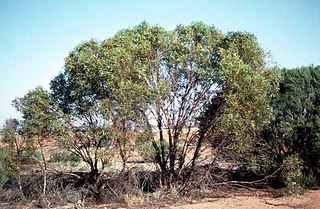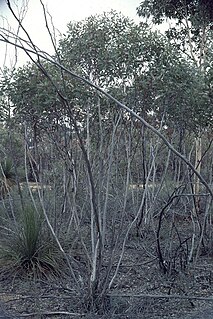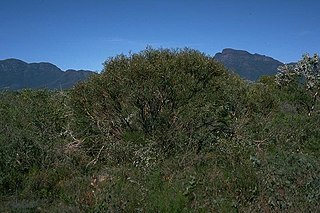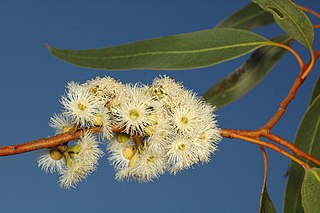
Eucalyptus argutifolia, commonly known as Wabling Hill mallee or Yanchep mallee, is a mallee that is endemic to the south-west of Western Australia. It is a rare species with smooth bark, lance-shaped adult leaves, flower buds arranged in groups of seven or nine, white flowers and cylindrical to conical cup-shaped fruit.
Eucalyptus angularis, commonly known as Lesueur phantom mallee, is a rare species of mallee that is endemic to the south-west of Western Australia. It has rough bark at the base of the stems, smooth greyish bark above, lance-shaped adult leaves and flower buds in groups of about eleven, but the characteristics of the flowers and fruit have not been recorded.
Eucalyptus aspersa is a mallee, sometimes a tree that is endemic to the South West region of Western Australia. It usually has rough bark on its stems and branches, lance-shaped adult leaves, white flowers and urn-shaped fruit.

Eucalyptus × balanites, commonly known as Cadda Road mallee, is a tree or a mallee that is endemic to a small area of the south-west of Western Australia. It has rough, corky or flaky bark, lance-shaped adult leaves, flower buds in groups of eleven, creamy-white flowers and hemispherical to cup-shaped fruit.

Eucalyptus balladoniensis, commonly known as the Balladonia mallee, is a mallee that is endemic to an area in the south of Western Australia. It has rough bark on the lower half of its stems, smooth brownish bark above, lance-shaped leaves, flower buds in groups of seven, pale yellow flowers and hemispherical to more or less spherical fruit.

Eucalyptus brevipes, commonly known as the Mukinbudin mallee, is a mallee that is endemic to Western Australia. It has coarse, fibrous to flaky back on the trunk and larger branches, smooth grey to pinkish bark above. The adult leaves are linear to narrow lance-shaped, the flower buds are arranged in groups of seven, the flowers are white and the fruit is cylindrical or barrel-shaped.
Eucalyptus crispata, commonly known as the Yandanooka mallee, is a species of tall mallee that is endemic to a small area on the east coast of Western Australia. It has a stocking of rough bark near the base of its trunk, smooth grey bark above, lance-shaped adult leaves, flower buds in groups of between nine and eleven, whitish to yellowish cream flowers and cup-shaped, barrel-shaped or hemispherical to cylindrical fruit.

Eucalyptus exilis, commonly known as Boyagin mallee, is a species of mallee that is endemic to Western Australia. It has thin stems with smooth bark, lance-shaped adult leaves, flower buds in groups of eleven, white flowers and barrel-shaped to shortened spherical fruit.

Eucalyptus gittinsii, commonly known as northern sandplain mallee, is a species of mallee that is endemic to Western Australia. It has smooth greyish bark, sometimes with rough flaky bark near the base, lance-shaped to curved adult leaves, flower buds in groups of three, whitish flowers and cylindrical to barrel-shaped fruit.
Eucalyptus incerata, commonly known as Mount Day mallee, is a species of mallee that is endemic to southern Western Australia. It has smooth bark, lance-shaped adult leaves, flower buds with a long, horn-shaped operculum and arranged in groups of seven, yellow flowers and barrel-shaped to cup-shaped fruit.

Eucalyptus johnsoniana, commonly known as Johnson's mallee, is a species of mallee that is endemic to Western Australia. It has smooth, greyish brown bark, sometimes with flaky to fibrous brownish bark at the base, lance-shaped adult leaves, flower buds in groups of seven, creamy white flowers and shortened spherical fruit with an unusually small opening.

Eucalyptus lateritica, commonly known as laterite mallee, is a species of mallee that is endemic to a small area in the south-west of Western Australia. It has rough bark on the lower half of the trunk, smooth grey bark above, lance-shaped adult leaves, flower buds in groups of nine or eleven, white flowers and shortened spherical fruit.

Eucalyptus myriadena, also known as blackbutt, is a species of mallee or tree that is native to Western Australia. It has rough, coarse flaky bark on part of the trunk, smooth bark above, linear to narrow lance-shaped adult leaves, flower buds in groups of between nine and thirteen, white flowers and narrow cylindrical to barrel-shaped fruit. It is widely distributed in the wheatbelt and goldfield areas of the state.

Eucalyptus pachyloma, commonly known as Kalgan Plains mallee, is a species of mallee that is native to Western Australia. It has smooth, greyish bark, lance-shaped adult leaves, flower buds in groups of between seven and thirteen, white to cream-coloured flowers and conical to cup-shaped fruit.

Eucalyptus petraea, commonly known as granite rock box, is a species of mallee or a small tree that is endemic to Western Australia. It has thin, ribbony or flaky to fibrous bark on the lower trunk, smooth greyish above, lance-shaped adult leaves, flower buds usually in groups of seven, creamy white flowers and conical fruit.

Eucalyptus suberea, commonly known as Mount Lesueur mallee or cork mallee, is a species of mallee or a small tree that is endemic to a small area on the west coast of Western Australia. It has rough bark on some or all of the trunk, smooth white bark above, lance-shaped adult leaves, flower buds in groups of eleven to twenty or more, white flowers and shortened spherical fruit.

Eucalyptus buprestium, also known as the apple mallee or ball-fruited mallee, is a small mallee that is endemic to an area along the south coast of Western Australia. It has smooth bark, narrow lance-shaped adult leaves, flower buds arranged in groups of between nine and fifteen, white flowers and almost spherical fruit with a small opening.

Eucalyptus celastroides, commonly known by the Noongar name of mirret, is a species of eucalypt that is endemic to the south-west of Western Australia. It is a mallee, rarely a tree, and has rough bark on about half of the lower half of its tunk, smooth above, narrow lance-shaped adult leaves, flower buds in groups of seven or nine, white flowers and urn-shaped fruit.
Eucalyptus cuprea, commonly known as the mallee box, is a species of mallee that is endemic to the west coast of Western Australia. It has rough, flaky bark on the base of its trunk, smooth coppery-coloured bark above, lance-shaped adult leaves, flower buds in groups of seven, creamy white flowers and conical to cup-shaped fruit.

Eucalyptus diminuta, commonly known as the spring mallee, is a species of mallee that is endemic to south-west of Western Australia. It has smooth, silvery to greyish bark, sometimes with rough flaky bark near the base, lance-shaped adult leaves, pendulous, elongated flower buds arranged in groups of seven, creamy white flowers and cup-shaped to bell-shaped fruit.















